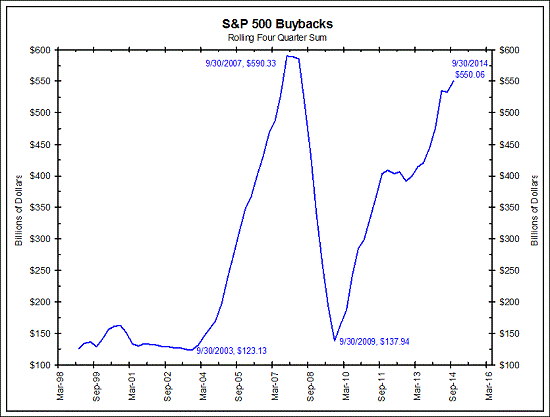
EXECUTIVES OF THE TOP EARNING COMPANIES HAVE USED 4% OF THE GDP TO IMPROVE WORTH OF THEIR OWN COMPANY'S STOCKS,
WHILE CUTTING NEEDED FUNDS FOR JOB CREATION, RESEARCH AND DEVELOPMENTS FOR A REAL, LONG TERM FUTURE.

(S&P 500 BUYBACKS IN THE BILLIONS)
Is the U.S. economy truly on the road to recovery? Many people point to the rising stock market numbers as evidence of a healthy and robust economy. Five years after the official end of the Great Recession corporate profits are at a record high and the stock market is booming.
However, what is not being discussed, is how the practice of share repurchasing (stock buy backs) is inflating the value of stocks while a dire lack of funds are being allocated towards things that actually improve economic growth - such as job creation, economic development and research. Today we are seeing a hyper focus on stock value as a determination of a company's worth. We are seeing an unhealthy obsession with “shareholder value maximization,” or SVM, rather than real economic growth. Not only has SVM become a false rubric of economic health, but there are also many incentives for executives to put as much of the company's money as possible into the practice of share repurchasing; executives are often given stock based compensation. Stock based compensation gives executives incentive to focus on the value of a company's stock, to the exclusion of their company's actual benefit to the economy at large. In fact, many companies today are spending more of their money on stock repurchasing, rather than the actual research and development of their product. The executives of Fortune 500 companies that are engaging in this practice are reaping in record profits like never before, while the prospect of building a real economic future fades from sight.
HALF OF CORPORATE PROFITS ARE GOING TO STOCK BUY BACKS, NOT RESEARCH, DEVELOPMENT OR HIRING
Last year alone, U.S. corporations spent about $700 billion, or roughly 4 percent of the GDP, to prop up their share prices by repurchasing their own stock. Over the past decade alone, S&P 500 companies have spent an astounding 54 percent of profits on stock buy backs while dividends absorbed an additional 37% of earnings (The Atlantic, 2015).
Wal-Mart for example, has spent about 47% of their profits on stock buy backs over the last 10 years. That's an average of more than $6.5 billion a year in stock repurchasing. If that money had gone towards Wal-Mart workers instead, it would have been enough to give each of the 1.4 million workers a $4,670 a year raise (PBS, 2015).
So digest this fact for a moment. America's top earning companies have spent more than half of their profits not on development, not on research, not on employment and certainly not on raising the wages and benefits for their employees, but instead on purchasing their own stocks.
In fact, many companies have used funds for stock repurchases while laying off massive numbers of their own employees. When Pfizer (a pharmaceutical company) cut its research budget in 2011 and laid off 1,100 employees, it was not because the company needed to save money, but rather because they wanted to use the extra funds for purchasing more of their own stock. The drug maker had so much cash left over in 2011 after the massive cuts that it decided to buy back an additional $5 billion worth of stock on top of the $4 billion already earmarked for repurchases in 2011 and beyond (The New York Times, 2011).
IT'S A WIN-WIN SOLUTION FOR THE RICH
AND A LOSE-LOSE RESULT FOR THE REST OF US
So has the wealth of the average American worker benefited from this growth of the GDP and the inflated corporate profits? Has trickle down economics succeeded in the wake of loose economic regulations? No. The truth is the direct opposite. Most Americans are not sharing in the prosperity of the growing GDP, job growth is anemic, minimum wage is back to where it was in the 1960's (adjusting for inflation), and our nation can no longer seem to afford even its most basic needs. In fact, American wages as a share of GDP have fallen in almost exact proportion to profit’s rise (The Atlantic, 2015).
Share buy backs have not fulfilled their stated purpose of rewarding investors over the last decade, experts say. “It’s a symptom of a deeper problem, which is a lack of investment in the long term,” said William W. George, a Harvard Business School professor and former chief executive of Medtronic, a medical technology company. “If we’re not investing in research, innovation and entrepreneurship, we’re going to be a slow-growth country for a decade (The New York Times, 2011).”
“It’s an extraordinarily unimaginative way to use money,” said Robert Reich, a former secretary of labor under President Clinton who now teaches public policy at the University of California, Berkeley. After diving in the wake of the financial crisis, buy backs have made a remarkable comeback in recent years, with $445 billion authorized this year, the most since 2007, when repurchases peaked at $914 billion (The New York Times, 2011).
IN 1982, RULE 10B-18 OF THE SECURITIES EXCHANGE ACT LOOSENS REGULATIONS
Things weren't always this way. In the past, the money flowed through the broader economy in the form of higher wages or increased investments in plants and equipment. But today, stock buy backs drain trillions of dollars of windfall profits out of the real economy and into a paper-asset bubble, inflating share prices while producing nothing of tangible value. We have gone from an economy based on value production to one based on value extraction. Corporate managers have always felt pressure to grow earnings per share, or "EPS", but where once their only option was the hard work of actually growing earnings by selling better products and services, they can now simply manipulate their EPS by reducing the number of shares outstanding. (Harvard Business Review, 2014)
Before 1982, when John Shad, a former Wall Street CEO in charge of the Securities and Exchange Commission loosened regulations that define stock manipulation, corporate managers avoided stock buy backs out of fear of prosecution.
Yet the rules changed when the SEC instituted Rule 10b-18 of the Securities Exchange Act.
Under this rule, a corporation’s board of directors is allowed to authorize senior executives to repurchase up to a certain dollar amount of stock over a specified or open-ended period of time, while requiring the company to publicly announce the buyback program. After that, management is allowed to buy a large number of the company’s shares on any given business day without fear that the SEC would charge it with stock-price manipulation—provided, among other things, that the amount did not exceed a “safe harbor” of 25% of the previous four weeks’ average daily trading volume. The new rules required the SEC to report total quarterly repurchases, but not daily ones, meaning that the SEC cannot determine whether a company has breached the 25% limit without a special investigation.
Loose regulations however, are not entirely to blame for the behavior of today's CEO's. We are simply pointing out that the passage of this legislation has helped increase the likelihood of the practice.
IT'S TIME TO END THE OPEN MARKET STOCK BUY BACKS
What are the solutions? It is time to end open market stock buy backs. It is time to rein in stock-based pay. And we must transform the boards that determine executive compensation.
What our economy needs is real growth, not another bubble. Unless our top companies start engaging in practices that create a real economic future for America, we're going to see American industry strangled to death by corporate greed, while our competitors around the globe outpace us by leaps and bounds.
LINKS
Rule 10b-18 of the Securities Exchange Act
Rule 10b-5-1 and 10b-18 Repurchase Agreement (The SEC)
Rule 10b-18 (Investopia)
Related News Stories
Six Years Of Bull Market Bull (David Stockman, 3-11-15)
Stock Buybacks Are Killing the American Economy (The Atlantic, 2-8-15)
Column: The biggest scam bankrupting business and the middle class (PBS, 3-10-15)
Profits Without Prosperity (Harvard Business Review, September 2014)
Stock Repurchasing Explained for Beginners (YouTube VIDEO, 11-23-2014)
Companies turning again to stock buybacks to reward shareholders (The Washington Post, 12-15-13)
As Layoffs Rise, Stock Buybacks Consume Cash (New York Times, 11-21-11)
Books
Producing Prosperity: Why America Needs a Manufacturing Renaissance (Ebook)